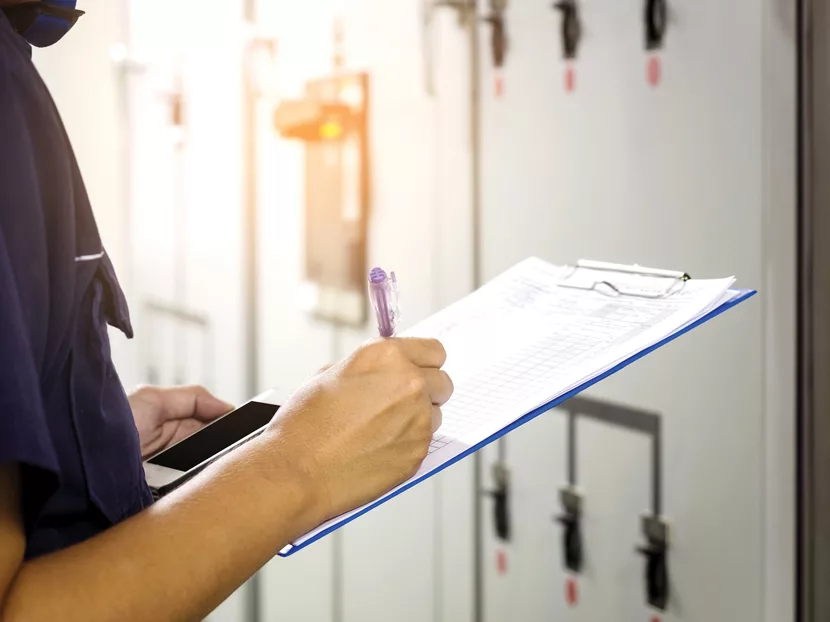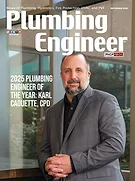Combi boilers, as the industry has so fondly coined the term, are the result of attempting to place a water heater and heating boiler in the same box. This has been an attractive concept to all involved, for as long as I can remember. When I first came on the scene, the most prominent combi boilers were cast iron oil/gas fired boilers, with a DHW heating coil that inserted into the cast iron block of the boiler. This coil was surrounded by hot water within the boiler and would transfer heat to the DHW as it passed through the coil.
This setup has worked quite well for many years and is still popular today. It is, however, starting to lose favor among many contractors and homeowners alike, as people are starting to realize the inherent inefficiencies with this setup. It is great in the winter time while the boiler is already operating to provide space heating. However, in the summer when there isn’t any requirement for space heating, the boiler must remain hot to provide DHW on demand. Having a 140 F-, 400-lb block of cast iron sitting in the basement all summer long is not efficient. There is constantly heat being lost up the chimney and to the surrounding space. The burner has to turn on from time to time just to keep the boiler hot, even if you are not using any DHW.
The location of the boiler’s temperature control probe presents another problem. Typically, there will be a probe that inserts into the boiler water, in the center of the DHW coil. This is necessary, so the boiler control is quickly able to sense a DHW draw and turn the burner on to replace the BTUs being extracted through the DHW coil. If it were not in this location, a large draw of DHW, such as filling a bathtub or a high-flow showerhead, would deplete the heat energy in the boiler before the burner turned on. The user would end up with several minutes of lukewarm water instead of hot water.
The problem is those small minute draws of DHW, such as washing your face and hands. There is typically enough heat energy available in the boiler to provide enough DHW for small draws without firing the burner. However, the burner often turns on unnecessarily for small draws like these because of the temperature probe location. That is inefficient as well.
In recent years, a new type of boiler has arrived on the scene; one the industry refers to as a Mod Con. The reason it is called Mod Con is because it has a modulating burner and the heat exchanger (HX) extracts so many BTUs that it lowers the flue temperature enough to condense. This type of boiler can get efficiencies of up to 95 percent; this is quite an improvement over the cast iron boilers we discussed earlier.
This type of boiler will typically only hold a small amount of water, as compared to the 20-30 gallons one may find in a cast iron boiler. This means there is a lot less heat to lose when the boiler turns off while it is still hot. The water is heated as it passes through the HX, while the burner automatically adjusts up and down to maintain the target water temperature.
So, how to get on-demand DHW from a unit such as this? There is no room for a DHW coil that can be found in a cast iron boiler. Fortunately, there are some brilliant engineers in our industry, and it didn’t take manufacturers long to figure it out.
The first thing that was needed was a larger burner. It takes 175,000 BTU/h to heat water from 50 F to 120 F at 5 gpm. This makes the boiler about four times than is needed for most of the residences here in South Central Pennsylvania. But that is what was necessary to produce DHW on demand. The boiler does not have much thermal mass; therefore the burner has to be able to produce the DHW without any thermal buffering.
The Mod Con combi boiler comes with two HXs. The primary HX extracts BTUs from the burner, and the secondary HX is a water-to-water HX. It extracts heat from the boiler water and thereby heats the DHW. There are several variations of these units. Some will have a small indirect tank that holds a few gallons of DHW. This is an excellent way to do it. There are always a few gallons of DHW sitting there, ready to go at a moment’s notice. Another common style is to use a FP-HX (flat plate-heat exchanger) as the secondary HX. When a DHW tap is turned on it activates a flow switch that turns on the burner. Hot boiler water is pumped through the one side of the FP-HX, transferring heat to the tap water that is flowing through the other side.
This type of boiler will typically come with an internal pump and a three-way motorized valve. The internal pump circulates the water through the primary HX whenever there is a call for either space heating or DHW. The three-way valve directs the hot boiler water either through the secondary HX for DHW, or out to the space heating system.
Homeowner’s perspective
The majority of homeowners I talk to give the thumbs up to the very idea of a Mod Con combi boiler. They don’t understand all the nuances of these units. They see an unobtrusive box on the wall that mysteriously heats both their house and provides DHW, while making almost no noise at all. Plus, they get to clear up close to 100 square feet of floor area in trade for a small area of wall space!
They also find the idea of doing all that work with only one appliance very efficient. And it comes at a good price as compared to a correctly sized Mod Con boiler with an indirect water heater.
As you can see, there is a lot that appeals to a homeowner here.
Contractor’s perspective
Any contractor that is well-educated in the art of hot water heating, knows that most combi boilers are an ill fit for the majority of residential homes. The most efficient boiler is one that is sized to the heat load of the house. It prevents short cycling and the associated mechanical wear and inefficiencies. Many good heating contractors’ first choice will be a Mod Con boiler sized to the heat load of the house. The DHW is then heated via an indirect water heater.
However, Mod Con combi boilers are rapidly gaining traction in the residential heating market. They are here to stay. Homeowners will keep buying them from contractors who will install them whether they are a good fit or not. Manufacturers will keep producing them as long as people are buying.
When you are approached by a homeowner who wants a new boiler installed, chances are, they are also getting prices from other people. Even if you have good referrals, they still want to price check. Chances are, they have gotten a price on a combi boiler. If they have, you may have a task on your hands to convince them that buying a correctly sized Mod Con boiler with an appropriately sized indirect water heater is worth the extra expense. Some homeowners will be convinced and some won’t. It depends on how well they trust you and what kind of budget they have to work with.
Where do they fit?
Let’s say the homeowner has decided they are going to have a combi boiler installed, for reasons only they know. Your job then becomes to decide whether a combi boiler will work in their application at all. If it doesn’t, just walk away and leave the future headaches for someone less scrupulous than you. You have your honor and reputation to protect.
But how does one decide whether or not a combi boiler is a fit? Different people have different ideas about it and are quite adamant that their way is the right way. Heating contractors tend to be that way. Your way might be different, but here is what I look for.
First, we have to get an idea of the home’s DHW requirements. Look for big garden tubs and rain showers first. They usually have high flow rates. You can determine what the flow rate of a fixture is with a five-gallon bucket and a stopwatch. See how long it takes to fill the bucket and convert it to gpm. Also talk to the occupants. Do they take back-to-back showers or multiple showers simultaneously? What you are after is the required flow rate of the DHW. This will determine the size of combi boiler that is required. In some cases, the flow rates are greater than the largest combi boiler can handle.
Next, examine the heating emitter system and the building’s heat load, as compared to the required size of the combi boiler. When comparing the heat load of the building to the size of the combi boiler, I typically draw the line at 25 percent. If the heat load is less than 25 percent of the required combi boiler, I’ll do my best to talk them into a different system. If they aren’t convinced, I gracefully take my leave and thank them for considering my services.
Equally important is the emitter system. If we are dealing with a high mass system, such as cast-iron radiators, chances are good for a successful install. They can also work well with baseboard and flat panel radiators. Basically, any emitter system that can shed heat rapidly with higher water temperatures, while not causing discomfort to the occupants. When the house is over-radiated (oversized emitters as compared to the buildings heat load), that is also something that works in your favor. Radiant floor heating is something you must be very careful with. You can’t readily turn the water temp up on a radiant floor without causing discomfort to the occupants. A single zone radiant system in a concrete slab may work well because of the thermal mass, although the required water temperature cannot be raised.
Also, look at the zoning. If the building has a lot of small zones, a combi boiler is not a good fit. Several zones are usually something you can work with.
How can we get the most out of them?
The best way to tame a combi boiler and prevent short cycling is with a buffer tank on the heating side of the system. This gives the boiler more thermal mass and promotes higher efficiencies. For this discussion, I am excluding buffer tanks since the homeowner couldn’t afford the additional expense of a Mod Con boiler tied to an indirect water heater. They also couldn’t afford the additional expense of a buffer tank. So let’s see what we can do without a buffer tank.
First, is the combi boiler selection. Having done the boiler sizing and met the above system criteria, I try to look for something with a large turn-down ratio. The lower the burner can modulate, the better it will match the emitter system requirements. Next, look for a unit that has the ability to derate the burner for a heat call while maintaining full capacity on a DHW call. What that means is you have the ability to cap the burner’s maximum fire rate at a percentage of its full capacity, for a space heating call. That is important because it changes the way the boiler behaves on a call for heat. It won’t allow the burner to over-fire as quickly and help stabilize the temperature output to the heating system.
Setting up the outdoor reset curve (ODR) will be an important and tricky part in the system. The ODR control modulates the water temp going to the heat emitters, based on the outdoor air temperature. The colder it gets outside, the hotter the water that goes to the system; and vice versa.
What I do is set up the ODR curve the way I would with a normal system. The upper limit is set at the maximum required temp to meet the load at design day, and the lower limit is set at the lowest required water temperature. Then it’s time for actual run testing. You will want to place the outdoor temperature sensor in an area that is around 60 F or so. This is to simulate the boiler’s response during shoulder seasons. Then I turn on the smallest heating zone in the system and monitor the runtimes of the boiler. When first starting this process, it will cycle rapidly. You want to start adjusting the minimum allowed water temp on the ODR curve. As you adjust the temperature to a higher setting, you will see the boiler’s runtimes increase and the short cycling decrease.
There is some controversy about what is the minimum runtime of a boiler. The longer the better, obviously, but the minimum I have heard from manufacturers is seven minutes. Hopefully you can achieve this runtime with the boiler still in condensing mode. The line between condensing and non-condensing is somewhere around 130 F return water temperature. When a Mod Con combi boiler is condensing, it greatly enhances the combustion efficiency. It is, however, more important to maintain that minimum runtime than it is to keep the boiler in condensing mode.






